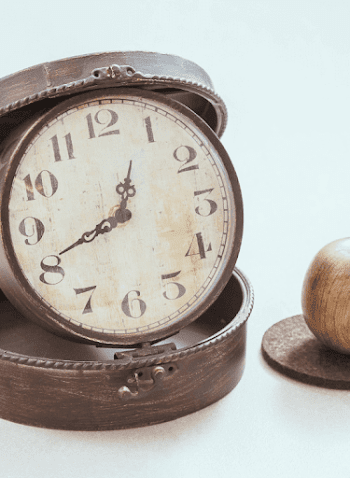UPDATE: Some suggestions in posts may no longer be available for AncestryDNA results. This is too massive and changing too fast for me to update everything at this time. There also seems to be a never-ending stream of minor visual changes so some images may once again be a previous version. I do review posts so this information is not completely out of date but if you need click-by-click instructions or photos, this post may not be what you need for that use. The tools and concepts are still relevant.

Ancestry DNA Tools : Are They Hidden? Can You Find Them?
In this post, I'll show you three features people treat like they're hidden, point out four "hidden in plain sight" features, make sure you're aware of the basic tools, and give you some hints for using the newly revealed information.
Don't worry, it's not an overwhelming amount of information. When we're done, you'll know where the hidden features are to make every visit to AncestryDNA more productive.
I'm covering these features in the order you'd encounter them if you go to the homepage, first. Once you've taken a test, this should be what comes up if you go to AncestryDNA.com. There's not really a natural order. Which tools help you most depend on what you're trying to do!
Autosomal DNA Tools at AncestryDNA
The DNA homepage is what Ancestry calls "Your DNA Results Summary." If you are skipping this page you might be missing out on some of the tools. I don't consider these hidden but people get different views based on their results so I'm going to go ahead and quickly look at this page as it is your starting place for lots of information.
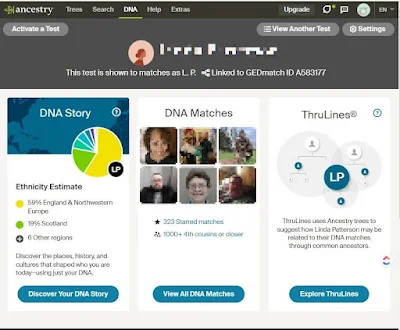
There is really a lot of information on this page although there are only four three tools featured. The tools are:
- DNA Story, which gives you your ethnicity information;
- DNA Matches, which should be the core of using DNA for genealogy;
- ThurLines. See this post to learn a little more about ThruLines.
ThruLines essentially rolls the two old tools, DNA Circles and New Ancestor Discoveries (NADs), together. I'm mentioning them because they had a bit of a learning curve. ThruLines is easier to use but many of the same warnings apply as the technology behind all three tools is essentially the same.
You may come across older posts talking about DNA Circles and NADs and the information may still be relevant but applies to ThruLines. This is just a heads-up as you continue on your genetic genealogy learning journey.
Honestly, you need to understand the finer points of all parts of genetic genealogy. You can be misled by any of this information if you don't understand what it's telling you.
Understanding your DNA matches can be a general skill, not specific just to AncestryDNA as can using your DNA Story. The DNA Story is a presentation unique to AncestryDNA, though. The concepts behind ThruLines is very popular. MyHeritageDNA offers the similar "Theory of Family Relativity." (I prefer this because it is clear it is a "theory," not a conclusion, and they will show you multiple options).
Let's look a little closer.
How to Use Your DNA Results with AncestryDNA's Tools
That brings me to the first feature, which may be hiding in plain sight for you.

Do you see the little gray circles with a question mark? Those will give you help on the specific tool or feature they appear by. Use them.
This is how you will learn what each tool is meant to tell you. If you are still struggling, look for other online information (not provided by Ancestry.com) to tell you more about the tool.
A different viewpoint or way of explaining may be what you need. Also, genetic genealogists will share the quirks they've noticed from using a tool. This can help you better understand the tool's purpose and limitations.
If you don't learn about an AncestryDNA tool from a lecture, webinar, course, or class, start with the question mark icon. This is the best way to learn how to use your DNA results with the in-house tools provided by AncestryDNA.
How to Change Your AncestryDNA Settings
Similarly, don't overlook the settings in the upper right corner of your summary page.
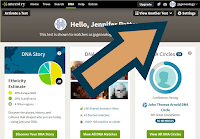
This is where you change the settings specific to your DNA results as opposed to the settings related to your Ancestry.com account (which are accessed from your username just above this "Settings" button, a bit confusing).
That's all I'm going to say about the summary page in this post as well as the DNA Story and ThruLines.
Ancestry DNA Changes 2019 – 2022
So there seems to be one change that keeps getting worse (if you're a new user of AncestryDNA). It seems the help icon on the list of matches has been removed. Below are comparison shots.



How to Use DNA for Genealogy, Faster
If you are new to using AncestryDNA, use those help icons. You now may need to go to the splash page (as pictured in the section above called "Autosomal DNA Tools at AncestryDNA") to access the basic help information. It is still available and you should be familiar with it.
MOST complaints I see newer DNA users make are actually explained by one of the help icon pop-ups I point out in this post.
Not concerned, don't like using "help" information, in a rush?
Think of it this way. You only have a limited amount of time to spend on genealogy and DNA. The time it takes you to email someone for help, or to post your complaint on social media or a message board could have been spent clicking a help icon, reading what it said, and then continuing with your genetic genealogy.
Yes, I believe you can do all three of those things in the time it takes you to ask for help or to complain about an issue. If you ask for help, you probably end up waiting for an answer so you could do a LOT more if your question is answered by a help icon.
There WILL be valid complaints and information not answered with a help icon. Make the best use of your genealogy time by using those help icons until you know everything they have to tell you or you know a better place to get the same kind of information. There will be plenty of things you will have to stop and look-up, thus stalling your DNA use.
Don't get stalled by something unnecessary.
DNA Matches : What do relationship estimates mean?
Here's the 2019 view of the pop-up so you are clear what I'm talking about in the rest of this section:

Because this is a close relationship, there aren't a lot of choices.
In a moment I'm going to show you another hidden feature which can help you seek out this same kind of information. But then you'll have to determine the most likely relationships from all the choices possible, not just the choices relevant to you and that one match.
Opening this pop-up gives you the most likely options between you and this match.
The major complaint I see that this information resolves is the "wrong" relationship being listed.
This is me and my great-aunt (Ancestry calls this a "grandaaunt" which is technically correct. Most people I've talked to say "great-aunt." Be careful with this type of relationship as a great-grandaunt is what most people call a great-great-aunt. You must be consistent using "grand" or excluding it!) This relationship is grouped under "1st cousin." This is a grouping. We are correctly grouped under 1st cousin.
The grouping is determined solely on the amount of DNA (the cMs) you share. The grouping is never wrong.
You could think of this like going to check-in to an event and they have several lines to group people based on their last name. Your last name is Smith and the line is for M-Z. That is the correct grouping even though your last name is not "M-Z." Your specific last name belongs in that group just as the specific amount of shared DNA belongs in the DNA group (I think it was a mistake giving the groups relationship names because it is confusing but it wasn't my choice).
I want to make another parallel to the check-in situation if you think the website should tell you the exact relationship. When you walk in the door at an event, someone doesn't point you to the right line immediately (without speaking to you and learning your last name, that is). The groupings are provided to make the process faster. You have to figure out the specifics to use the groupings (the specific is what your last name is).
If you don't know your last name, someone can't get you to the right line. That's exactly how these DNA groupings work. The groupings let you focus on groups of relationships making it easier to work with a long list of matches. You need to use details you have (the website doesn't have these details) to figure out your specific situation.
Unfortunately DNA is a lot harder than knowing your own last name. Just imagine the type of help you'd get when you try and check-in if you don't know your last name. In the same way, the website doesn't give you an exact answer because it doesn't have all the information.
It is up to you to gather the details to determine the actual relationship.
Filter, search, and categorize AncestryDNA Matches
2019 vs. 2020 Changes---I'm working on it.
The filters and searching options have changed the most (and this seems to be a change for the better). This is also the feature that takes me the longest to update so below is the 2020 image so you can see the difference but below that is the 2019 information. I just can't update all of this right now. All the 2019 options are there but things have been rearranged.
2020 view

2019 (unupdated) information:
Before I move on to the individual match view, I want to point out the other features that aren't hidden (but may be overlooked) on your match list.
First, for those of you who might be feeling a bit disoriented with the change...

What information you are given has not changed but it's been condensed, moved, and some (obvious) additions have been made.
The image below if a gif of the dropdown list for "Groups." If it's not working, you can simply click the "Groups" dropdown for your test to see the options. I'm not going to talk about every option so this isn't vital.

Which options you have depends on if your parents were tested and if you have regions listed in your DNA Story.
Note that the "regions" are now under that "Map" icon that replaced the help icon in the upper right corner. I'm not going to talk about them because I have very little experience with them (that happens when all your ancestors are from one state).
For those of you with "normal" family trees, the regions may be very helpful in separating out your options. Don't consider it a slam dunk, though. My father-in-law has a far more diverse family tree than me or his wife but I've found most of his matches have a very similar diverse family tree, so the regions still don't tell me which branch a match likely belongs to!
You'll find regions helpful when comparing someone who doesn't share parts of your geographical ancestry (so if my husband and I showed up as matches, which thankfully we don't, I would know I don't match any of his paternal regions or, in reverse, he'd know I must be a maternal match because I don't have any shared regions with his father---but an ethnicity comparison would not reveal this. The lesson, don't just rely on one tool!).
So what are these dropdowns?
"Groups" Drop-down
It has added a custom grouping (this is one of the options you previously needed an extension for) as well as the starred matches. Previously the starred matches was the only "group" filter available, then the extensions allowed you more options. This update makes the grouping features of the extensions unnecessary.
I'll mention the custom groups in a moment.
Now you can also focus on the actual groupings (close-4th cousin or distant cousins) without actually having to flip pages. You also have some enhanced option for new matches and hidden matches.
The parental filtering is now under "Groups" (only available if a parent was tested).
"Filters" Drop-down
OK, the "Filters" have some new features. You may not think these are exciting but this is where I have a LOT to write about (as in updating other posts and writing new posts because it's too much to cover here).
I just have a few quick notes for these filters since they could result in entire posts.
- "Common ancestors" uses ThruLines. This works better than the old ancestor hints but is also more dangerous. Make sure you understand how ThruLines works as it can show you the wrong ancestor and you'll be off chasing the wrong family (or spinning in circles---which happens if you have lots of interrelated lines OR your matches have lots of interrelated lines. This second scenario is the dangerous one because you might not be aware of it. As a southern specialist, let me pass on a warning. If you have southern ancestors, assume you or your matches have interrelated lines). You can see my initial suggestions about safely using ThruLine in this post.
- The new "Messaged" filter can help you focus. See this post for more tips on messaging AncestryDNA matches.
- That "Notes" filter is just a filter. You still can't search your notes, disappointing, I know. Use the custom groups to help with this.
Searching Ancestry DNA Matches
So there is a new feature with "Search!"It now does search user names which is a HUGE benefit.
It still does not search notes.
When it searches a tree, it has to recognize the information as what it's searching for (so location search is for birth location only, which is not ideal, plus the tree has to have the birth location entered so it's recognizable as what locationyou searched for and the birth location, i.e. the tree owner didn't make a mistake).
You can only search for one surname so good luck when you have a combination of something like Smith and something everyone spells differently! Your search won't be efficient for either of those.
Search does NOT search...
- matches without trees---UPDATE, the username will be searched, now,
- locations other than birth location,
- locations not recognized as what you entered,
- or surnames not in the surname field.
Although I'm thrilled the username can be searched, this will cause issues if you search for a common name as you'll get username and tree results.
The search feature is STILL a really weak area of Ancestry DNA.
What about that "Categorizing" item I promised?
Use the "Custom groups" to create categories or groups. There are lots of ways to do this (which will be separate posts, isn't your head already spinning?). I am using my custom groups to match my "buckets," right down to the colors, to make my life easier. That's just one way to use them.Learn a little about how I like to use DNA clustering ("bucketing" with my technique) in this post.
Note Taking in AncestryDNA


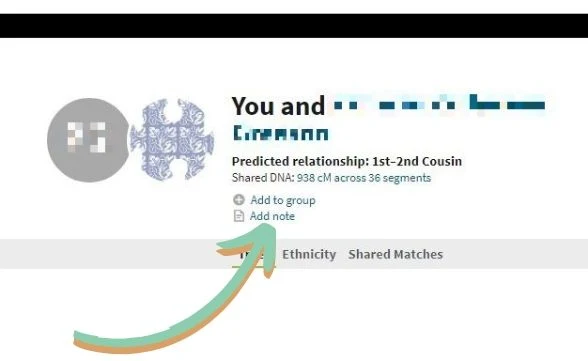
The notes field may not jump out at you with the small text and note icon.
This is a private note field just for you. Your match can't see it. It's not searchable and now a preview of your note will appear on the list of matches or list of shared matches.
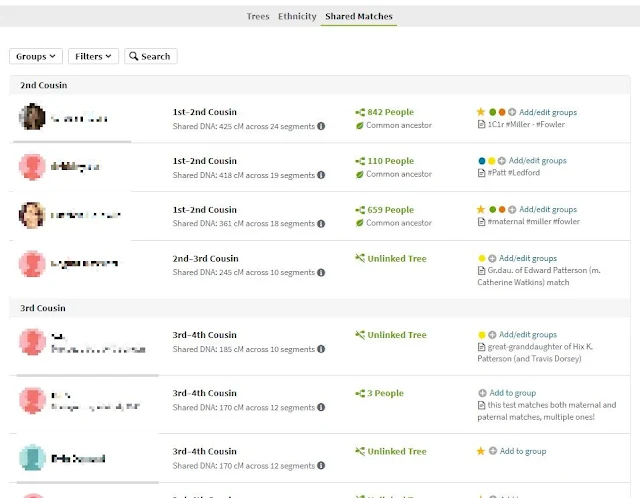
This is a list of Shared Matches and you can see in the far right column the "custom groups" I've created and the start of each note under them.
I use my notes along with my 4 Buckets Technique so I keep them pretty short. The first match here shows my preferred format (the hashtags are from the MedBetterDNA extension which may or may not work since the recent update but no need to change them).
You can create your own "Faux Buckets Technique" using the custom groups. (This is something I am updating in my "Road to DNA Success Program" now that this update is available.
Being able to see these notes on the match list of shared match list is really helpful. If I suspect a match belongs to a shared ancestral line based on the shared matches, the note (and custom groups) can make this clearer.
Quickly reviewing my notes for the shared matches can help me decide what I want to do with a match: contact them, star them, leave it alone and work on other matches, or something else.
You Need More Than AncestryDNA
Only using the information provided at AncestryDNA is only using clues. If you want to confirm the genetic relationship, you need more than those clues.
Estimating Relationships Without Segment Data
If you want to use your shared DNA to best estimate your relationship to a match (particularly when you can't get a match to respond or transfer to GEDmatch or another site with segment data), I recommend using Blaine Bettinger's The Shared cM Project.This is an amazing project where Blaine has requested people submit their DNA amounts for known relationships. He's had the statistical work done on these real-life examples as opposed to estimates that rely on statistical models/hypothetical amounts of shared DNA.
To learn more about autosomal DNA statistics in general, check out the ISOGG Wiki page on autosomal DNA statistics.
Another AncestryDNA Quirk
One final note about shared DNA reported at AncestryDNA.AncestryDNA uses a different algorithm that results in more shared segments being reported than at other companies. Be aware of this if you are comparing shared DNA from AncestryDNA against information from another source (this is explained in the shared DNA/estimated relationship pop-up when you expand the section on "How do we estimate DNAT relationships?"). It is normal to see slight variations in the amount of shared DNA as reported by different companies (including the same results uploaded/transferred elsewhere).
The number of segments reported at AncestryDNA should be higher for your close matches. For more distant matches where you have only a few shared segments, it can be confusing (are those two segments really one larger segment or two distinct segments?).
This is just one more reason you want to try and obtain segment data from a site like GEDmatch. Compare apples to apples instead of grapefruit and tangelos.
Getting More from AncestryDNA
Hopefully, now you know there is more information available at AncestryDNA than meets the eye. Finding the "hidden" information and knowing what to do with it can really improve your genetic genealogy results.However, if you really want to confirm a shared relationship from DNA (not just a shared relationship based on a family tree), you are going to have to use other tools such as GEDmatch, or upload your results to another company such as FamilyTreeDNA or MyHeritageDNA. You could also pay for another test at a company that provides segment information.
Learn more about GEDmatch in my post The Free DNA Tool You Need to Know. Find more posts about DNA and genetic genealogy here.
Do you have questions or suggestions for using these "hidden" features? Leave a comment!







